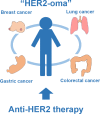Next generation sequencing-based gene panel tests for the management of solid tumors
- PMID: 30338623
- PMCID: PMC6317963
- DOI: 10.1111/cas.13837
Next generation sequencing-based gene panel tests for the management of solid tumors
Abstract
Next generation sequencing (NGS) has been an invaluable tool to put genomic sequencing into clinical practice. The incorporation of clinically relevant target sequences into NGS-based gene panel tests has generated practical diagnostic tools that enable individualized cancer-patient care. The clinical utility of gene panel testing includes investigation of the genetic basis for an individual's response to therapy, such as signaling pathways associated with a response to specific therapies, microsatellite instability and a hypermutated phenotype, and deficiency in the DNA double-strand break repair pathway. In this review, we describe the concept of precision cancer medicine using target sequences in gene panel tests as well as the importance of the control of sample quality in routine NGS-based genomic testing. We describe geographic and ethnic differences in cancer genomes, and discuss issues that need to be addressed in the future based on our experiences in Japan.
Keywords: DNA double-strand break repair pathway; gene panel test; hypermutation; next generation sequencing; precision cancer medicine.
© 2018 The Authors. Cancer Science published by John Wiley & Sons Australia, Ltd on behalf of Japanese Cancer Association.
Figures




References
Publication types
MeSH terms
Grants and funding
LinkOut - more resources
Full Text Sources
Medical

